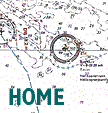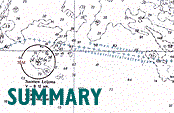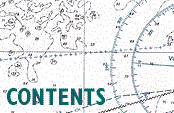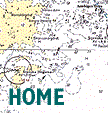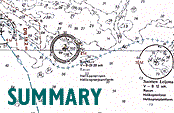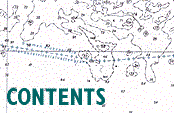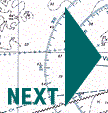 |
The Estonian-flagged ro-ro passenger ferry ESTONIA (Figure 1.1) departed from Tallinn, the capital of Estonia, on 27 September 1994 at 1915 hrs for a scheduled voyage to Stockholm, the capital of Sweden (Figure 1.2). She carried 989 people, 803 of whom were passengers.
Figure 1.1 The ro-ro passenger ferry ESTONIA.
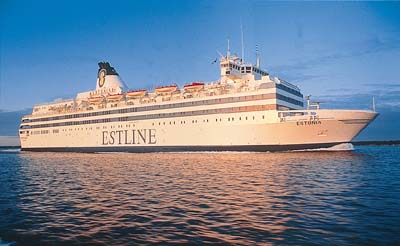
Figure 1.2 The ESTONIA’s route and the site of the accident.
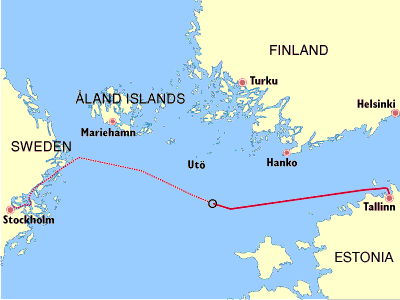
The ship left harbour with all four main engines running. When she was clear of the harbour area full service speed was set. The engine setting was maintained up to the accident. The wind was southerly, 8-10 m/s. Visibility was good, with rain showers.
 At 2000 hrs the watch on the bridge was taken by the second officer B and the third officer (The estonia had two second officers, here designated second officer A and second officer B). At 2000 hrs the watch on the bridge was taken by the second officer B and the third officer (The estonia had two second officers, here designated second officer A and second officer B).
 The voyage proceeded normally. Sea conditions along the Estonian coast were moderate, but became more rough when the ship left the sheltered waters. The ship had a slight starboard list due to a combination of athwartships weight disposition, cargo disposition and wind pressure on the port side. The voyage proceeded normally. Sea conditions along the Estonian coast were moderate, but became more rough when the ship left the sheltered waters. The ship had a slight starboard list due to a combination of athwartships weight disposition, cargo disposition and wind pressure on the port side.
 As the voyage continued the wind velocity increased gradually and the wind veered to south-west. Visibility was generally more than 10 nautical miles. At midnight the wind was south-westerly 15-20 m/s with a significant wave height of 3-4 m. The rolling and pitching of the vessel increased gradually, and some passengers became seasick. As the voyage continued the wind velocity increased gradually and the wind veered to south-west. Visibility was generally more than 10 nautical miles. At midnight the wind was south-westerly 15-20 m/s with a significant wave height of 3-4 m. The rolling and pitching of the vessel increased gradually, and some passengers became seasick.
 At about 0025 hrs the ESTONIA reached a waypoint at position 59°20´ N, 22°00´ E and from there headed true course 287°. The speed was about 14 knots and the vessel encountered the seas on her port bow. Due to increasing rolling, the fin stabilisers were extended. At about 0025 hrs the ESTONIA reached a waypoint at position 59°20´ N, 22°00´ E and from there headed true course 287°. The speed was about 14 knots and the vessel encountered the seas on her port bow. Due to increasing rolling, the fin stabilisers were extended.
 During his scheduled round on the car deck the seaman of the watch heard shortly before 0100 hrs a metallic bang from the bow area as the vessel hit a heavy wave. During his scheduled round on the car deck the seaman of the watch heard shortly before 0100 hrs a metallic bang from the bow area as the vessel hit a heavy wave.
 The seaman of the watch informed the second officer B about what he had heard and was ordered to try to find out what had caused the bang. The seaman did so by waiting at the ramp, listening and checking the indicator lamps for the visor and ramp locking devices. He reported that everything seemed to be normal. The seaman of the watch informed the second officer B about what he had heard and was ordered to try to find out what had caused the bang. The seaman did so by waiting at the ramp, listening and checking the indicator lamps for the visor and ramp locking devices. He reported that everything seemed to be normal.
 At 0100 hrs the watch on the bridge was taken over by the second officer A and the fourth officer. After being relieved the second officer B and third officer left the bridge. At 0100 hrs the watch on the bridge was taken over by the second officer A and the fourth officer. After being relieved the second officer B and third officer left the bridge.
 Further observations of unusual noise, starting at about 0105 hrs, were made during the following 10 minutes by many passengers and some crew members who were off duty in their cabins. Further observations of unusual noise, starting at about 0105 hrs, were made during the following 10 minutes by many passengers and some crew members who were off duty in their cabins.
 When the seaman of the watch returned from his round, soon after the change of watches, he caught up the master and entered the bridge just behind him. Shortly afterwards he was sent down to the car deck to find out the cause of the sounds reported by telephone to the bridge. He did not, however, manage to reach the car deck. When the seaman of the watch returned from his round, soon after the change of watches, he caught up the master and entered the bridge just behind him. Shortly afterwards he was sent down to the car deck to find out the cause of the sounds reported by telephone to the bridge. He did not, however, manage to reach the car deck.
 At about 0115 hrs the visor separated from the bow and tilted over the stem. The ramp was pulled fully open, allowing large amounts of water to enter the car deck. Very rapidly the ship took on a heavy starboard list. She was turned to port and slowed down. At about 0115 hrs the visor separated from the bow and tilted over the stem. The ramp was pulled fully open, allowing large amounts of water to enter the car deck. Very rapidly the ship took on a heavy starboard list. She was turned to port and slowed down.
 Passengers started to rush up the staircases and panic developed at many places. Many passengers were trapped in their cabins and had no chance of getting out in time. Lifejackets were distributed to those passengers who managed to reach the boat deck. They jumped or were washed into the sea. Some managed to climb into liferafts which had been released from the vessel. No lifeboats could be launched due to the heavy list. Passengers started to rush up the staircases and panic developed at many places. Many passengers were trapped in their cabins and had no chance of getting out in time. Lifejackets were distributed to those passengers who managed to reach the boat deck. They jumped or were washed into the sea. Some managed to climb into liferafts which had been released from the vessel. No lifeboats could be launched due to the heavy list.
 At about 0120 hrs a weak female voice called “Häire, häire, laeval on häire” the Estonian words for “Alarm, alarm, there is alarm on the ship”, over the public address system. Just a moment later an internal alarm for the crew was transmitted over the public address system. Soon after this the general lifeboat alarm was given. At about 0120 hrs a weak female voice called “Häire, häire, laeval on häire” the Estonian words for “Alarm, alarm, there is alarm on the ship”, over the public address system. Just a moment later an internal alarm for the crew was transmitted over the public address system. Soon after this the general lifeboat alarm was given.
 A first Mayday call from the ESTONIA was received at 0122 hrs. A second Mayday call was transmitted shortly afterwards and by 0124 hrs 14 ship- and shore-based radio stations, including the Maritime Rescue Co-ordination Centre (MRCC) in Turku, had received the Mayday calls. A first Mayday call from the ESTONIA was received at 0122 hrs. A second Mayday call was transmitted shortly afterwards and by 0124 hrs 14 ship- and shore-based radio stations, including the Maritime Rescue Co-ordination Centre (MRCC) in Turku, had received the Mayday calls.
 At about this time all four main engines had stopped. The main generators stopped somewhat later and the emergency generator started automatically, supplying power to essential equipment and to limited lights in public areas and on deck. The ship was now drifting, lying across the seas. At about this time all four main engines had stopped. The main generators stopped somewhat later and the emergency generator started automatically, supplying power to essential equipment and to limited lights in public areas and on deck. The ship was now drifting, lying across the seas.
 The list to starboard increased and water had started to enter the accommodation decks. Flooding of the accommodation continued with considerable speed and the starboard side of the ship was submerged at about 0130 hrs. During the final stage of flooding the list was more than 90 degrees. The ship sank rapidly, stern first, and disappeared from the radar screens of ships in the area at about 0150 hrs. The list to starboard increased and water had started to enter the accommodation decks. Flooding of the accommodation continued with considerable speed and the starboard side of the ship was submerged at about 0130 hrs. During the final stage of flooding the list was more than 90 degrees. The ship sank rapidly, stern first, and disappeared from the radar screens of ships in the area at about 0150 hrs.
 Rescue efforts were initiated by MRCC Turku. About one hour after the ESTONIA had sunk, four passenger ferries in the vicinity arrived on the scene of the accident. Rescue helicopters were summoned and the first one arrived at 0305 hrs. Rescue efforts were initiated by MRCC Turku. About one hour after the ESTONIA had sunk, four passenger ferries in the vicinity arrived on the scene of the accident. Rescue helicopters were summoned and the first one arrived at 0305 hrs.
 During the night and early morning, helicopters and assisting ships rescued 138 people, of whom one later died in hospital. During the day and on the two following days 92 bodies were recovered. Most of the missing persons accompanied the vessel to the seabed. During the night and early morning, helicopters and assisting ships rescued 138 people, of whom one later died in hospital. During the day and on the two following days 92 bodies were recovered. Most of the missing persons accompanied the vessel to the seabed.
 The wreck was found in international waters within Finland's Search and Rescue Region, resting on the seabed at a water depth of about 80 m with a heading of 95° and a starboard list of about 120°. The visor was missing and the ramp partly open. The wreck was found in international waters within Finland's Search and Rescue Region, resting on the seabed at a water depth of about 80 m with a heading of 95° and a starboard list of about 120°. The visor was missing and the ramp partly open.
 The position of the wreck is 59°22,9´ N, 21°41,0´ E. The visor, which has been recovered, was located at 59°23,0´ N, 21°39,2´ E, about one nautical mile west of the wreck. The position of the wreck is 59°22,9´ N, 21°41,0´ E. The visor, which has been recovered, was located at 59°23,0´ N, 21°39,2´ E, about one nautical mile west of the wreck. |
 |

